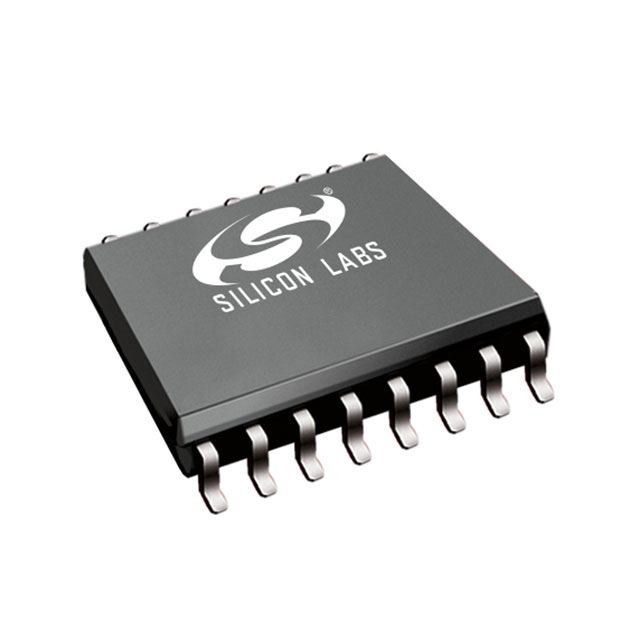Viz Specifikace pro podrobnosti o produktu.

EFM8BB10F8I-A-SOIC16
Product Overview
Category
The EFM8BB10F8I-A-SOIC16 belongs to the category of microcontrollers.
Use
This microcontroller is commonly used in various electronic devices and systems for controlling and processing data.
Characteristics
- High-performance 8-bit microcontroller
- Low power consumption
- Small form factor
- Integrated peripherals for enhanced functionality
Package
The EFM8BB10F8I-A-SOIC16 is available in a SOIC16 package, which stands for Small Outline Integrated Circuit with 16 pins.
Essence
The essence of this microcontroller lies in its ability to provide efficient control and processing capabilities in a compact package.
Packaging/Quantity
The EFM8BB10F8I-A-SOIC16 is typically packaged in reels or tubes, with a quantity of 2500 units per reel/tube.
Specifications
- Architecture: 8-bit
- Clock Speed: Up to 50 MHz
- Flash Memory: 8 KB
- RAM: 1 KB
- Operating Voltage: 2.7V to 3.6V
- Digital I/O Pins: 14
- Analog Inputs: 8
- Communication Interfaces: UART, SPI, I2C
- Timers/Counters: 4
- ADC Resolution: 12-bit
- PWM Channels: 4
- Operating Temperature Range: -40°C to +85°C
Detailed Pin Configuration
The EFM8BB10F8I-A-SOIC16 has a total of 16 pins, each serving a specific purpose. The pin configuration is as follows:
- P0.0 - GPIO / ADC0
- P0.1 - GPIO / ADC1
- P0.2 - GPIO / ADC2
- P0.3 - GPIO / ADC3
- P0.4 - GPIO / ADC4
- P0.5 - GPIO / ADC5
- P0.6 - GPIO / ADC6
- P0.7 - GPIO / ADC7
- P1.0 - GPIO / UART0_TX
- P1.1 - GPIO / UART0_RX
- P1.2 - GPIO / SPI0_MISO
- P1.3 - GPIO / SPI0_MOSI
- P1.4 - GPIO / SPI0_CLK
- P1.5 - GPIO / SPI0_CS
- VDD - Power Supply (2.7V to 3.6V)
- GND - Ground
Functional Features
- High-performance 8-bit core for efficient processing
- Integrated peripherals such as UART, SPI, and I2C for communication
- Analog-to-Digital Converter (ADC) for precise analog measurements
- Pulse Width Modulation (PWM) channels for controlling analog outputs
- Timers/Counters for accurate timing and event counting
- Low power consumption modes for energy efficiency
- Flexible GPIO pins for general-purpose input/output operations
Advantages and Disadvantages
Advantages
- High-performance capabilities
- Compact form factor
- Integrated peripherals enhance functionality
- Low power consumption
- Wide operating temperature range
Disadvantages
- Limited flash memory and RAM capacity
- Limited number of digital I/O pins
Working Principles
The EFM8BB10F8I-A-SOIC16 operates based on the principles of a typical microcontroller. It executes instructions stored in its flash memory, processes data, and controls various peripherals and interfaces based on the program logic. The clock speed determines the rate at which instructions are executed, while the integrated peripherals enable communication and interaction with external devices.
Detailed Application Field Plans
The EFM8BB10F8I-A-SOIC16 finds applications in various fields, including but not limited to: - Consumer electronics - Industrial automation - Internet of Things (IoT) devices - Home automation systems - Automotive electronics - Medical devices
Detailed and Complete Alternative Models
Some alternative models that offer similar functionality to the EFM8BB10F8I-A-SOIC16 include: - EFM8BB10F2G-A-QFN20 - EFM8BB10F4G-A-QFN24 - EFM8BB10F8G-A-QSOP24 - EFM8BB10F16G-A-QSOP32
These alternative models provide different package options and pin configurations while maintaining compatibility with the EFM8BB10F8I-A-SOIC16 in terms of architecture and functionality.
In conclusion, the EFM8BB10F8I-A-SOIC16 is a high-performance 8-bit microcontroller
Seznam 10 běžných otázek a odpovědí souvisejících s aplikací EFM8BB10F8I-A-SOIC16 v technických řešeních
Sure! Here are 10 common questions and answers related to the application of EFM8BB10F8I-A-SOIC16 in technical solutions:
Q: What is EFM8BB10F8I-A-SOIC16? A: EFM8BB10F8I-A-SOIC16 is a microcontroller from the EFM8 Busy Bee family, specifically designed for low-power applications.
Q: What are the key features of EFM8BB10F8I-A-SOIC16? A: Some key features include an 8051-compatible core, 8KB flash memory, 1KB RAM, multiple communication interfaces, and low power consumption.
Q: What are the typical applications of EFM8BB10F8I-A-SOIC16? A: EFM8BB10F8I-A-SOIC16 is commonly used in various applications such as IoT devices, home automation, industrial control systems, and sensor networks.
Q: How can I program EFM8BB10F8I-A-SOIC16? A: EFM8BB10F8I-A-SOIC16 can be programmed using the Silicon Labs' Integrated Development Environment (IDE) called Simplicity Studio, which supports C programming language.
Q: What voltage range does EFM8BB10F8I-A-SOIC16 operate on? A: EFM8BB10F8I-A-SOIC16 operates on a voltage range of 1.8V to 3.6V.
Q: Does EFM8BB10F8I-A-SOIC16 have any built-in peripherals? A: Yes, it has several built-in peripherals including UART, SPI, I2C, ADC, timers, and GPIO pins.
Q: Can EFM8BB10F8I-A-SOIC16 be used for battery-powered applications? A: Yes, EFM8BB10F8I-A-SOIC16 is suitable for battery-powered applications due to its low power consumption and sleep modes.
Q: What is the maximum clock frequency of EFM8BB10F8I-A-SOIC16? A: The maximum clock frequency is 50 MHz.
Q: Does EFM8BB10F8I-A-SOIC16 support analog-to-digital conversion (ADC)? A: Yes, it has a built-in 12-bit ADC with multiple channels.
Q: Is EFM8BB10F8I-A-SOIC16 compatible with other microcontrollers or development boards? A: EFM8BB10F8I-A-SOIC16 follows the standard 8051 architecture, making it compatible with other 8051-based microcontrollers and development boards.
Please note that these answers are general and may vary depending on specific requirements and configurations.

